Canon EF-S 55-250mm f/4-5.6 IS STM Lens Review
Canon EF-S 55-250mm f/4-5.6 IS STM Performance
At maximum aperture and 55mm sharpness is already outstanding in the centre of the frame, with the clarity towards the edges of the frame being not too far behind. Maximum performance is realised at f/5.6 for this focal length. Here sharpness is outstanding across the frame.With the lens zoomed to 135mm, sharpness at maximum aperture remains very high in the centre of the frame and good sharpness towards the edges. Peak sharpness across the frame is achieved at f/8 for this focal length. At this aperture, performance in the centre is still outstanding and sharpness towards the edges improves to very good levels.
Impressively, sharpness holds up very well at 250mm also. At maximum aperture, sharpness in the centre of the frame is still outstanding and good towards the edges of the frame. Peak performance is achieved between f/8 and f/11 for this focal length.
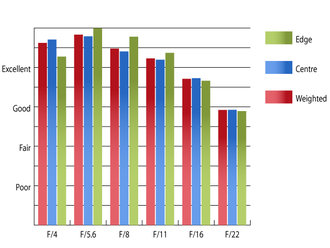 MTF@55mm | 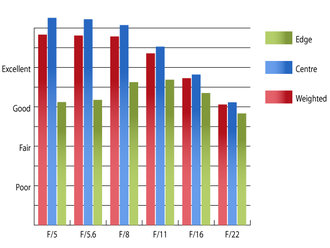 MTF@135mm |
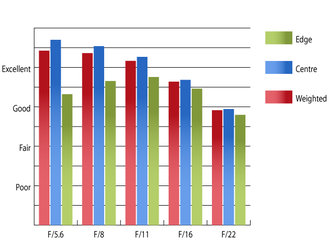 MTF@250mm | How to read our chartsThe blue column represents readings from the centre of the picture frame at the various apertures and the green is from the edges. Averaging them out gives the red weighted column.The scale on the left side is an indication of actual image resolution. The taller the column, the better the lens performance. Simple. For this review, the lens was tested on a Canon EOS 600D using Imatest. |
Chromatic aberrations are well controlled throughout the zoom range, only just exceeding half a pixel width on a few occasions. These low levels of CA will be difficult to spot, even in large prints, or harsh crops from the edges of the frame.
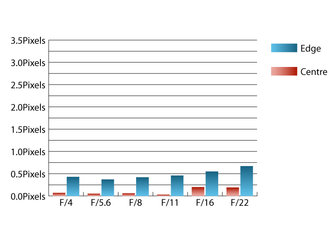 CA@55mm | 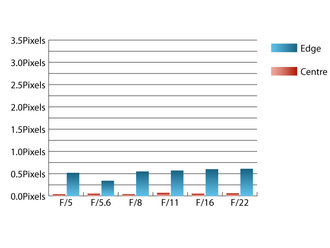 CA@135mm |
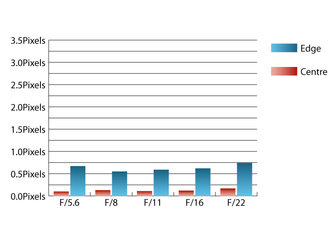 CA@250mm | How to read our chartsChromatic aberration is the lens' inability to focus on the sensor or film all colours of visible light at the same point. Severe chromatic aberration gives a noticeable fringing or a halo effect around sharp edges within the picture. It can be cured in software.Apochromatic lenses have special lens elements (aspheric, extra-low dispersion etc) to minimize the problem, hence they usually cost more. For this review, the lens was tested on a Canon EOS 600D using Imatest. |
Falloff of illumination towards the corners of the frame is reasonably well controlled. At 55mm the corners are 1.28 stops darker than the image centre at maximum aperture. At 135mm the corners are 1.69 stops darker than the image centre. Visually uniform illumination is achieved one stop below maximum aperture throughout the zoom range.
Distortion is well controlled, with Imatest detecting 1.39% barrel at 55mm at 0.824% pincushion at 250mm. This level of distortion should pose few issues, but may become apparently if straight lines are placed parallel to the edge of the frame, especially at 55mm. If straight lines are paramount, then you'll be glad to hear that the distortion pattern is uniform across the frame, which should make corrections relatively straightforward to apply.
No issues with flare were encountered during testing, with contrast only being slightly reduced when shooting directly into the light at wide apertures. However, no lens hood is supplied as standard, so if you require one for peace of mind, then an ET-63 hood can set you back around £11.
Add your message
Login required
Please login here or if you've not registered, you can register here. Registering is safe, quick and free.
Please login here or if you've not registered, you can register here. Registering is safe, quick and free.
photodo Stats
1102 lenses
428 MTF tests
74 in-depth photodo reviews
100+ users join each day
Help the lens community by reviewing or rating a lens today via our lens search
428 MTF tests
74 in-depth photodo reviews
100+ users join each day
Help the lens community by reviewing or rating a lens today via our lens search
Latest Lens Reviews
- Chinon 28mm f/2.8 Vintage Lens Review
- Canon EF 70-200mm f/4L IS II USM Lens Review
- Samyang AF 85mm f/1.4 EF Review
- Sigma 70mm f/2.8 DG Macro Art Review
- Samyang AF 24mm f/2.8 FE Review
- Meike 50mm f/1.7 Review
- Tamron 70-210mm f/4 Di VC USD Review
- Lensbaby Burnside 35mm f/2.8 Review
- Asahi Super Takumar 50mm f/1.4 Review
- Asahi Super-Multi-Coated Takumar 135mm f/3.5 Review
